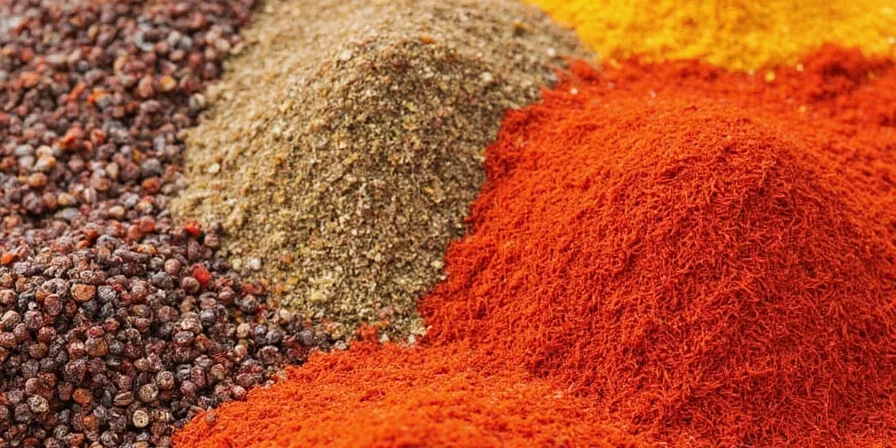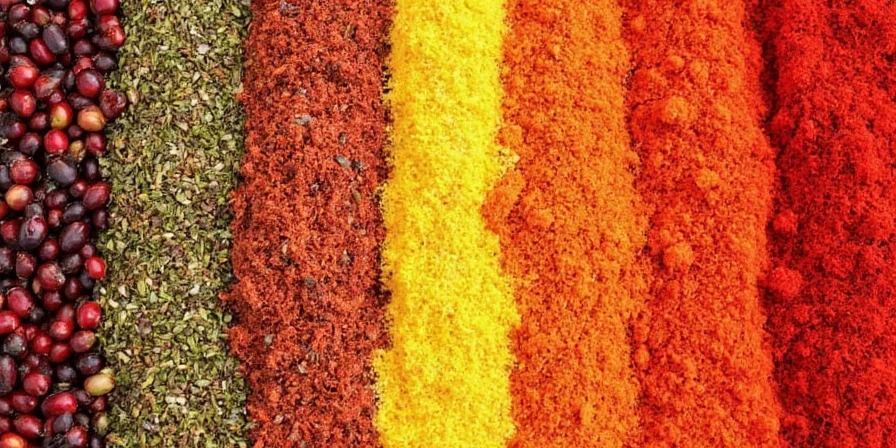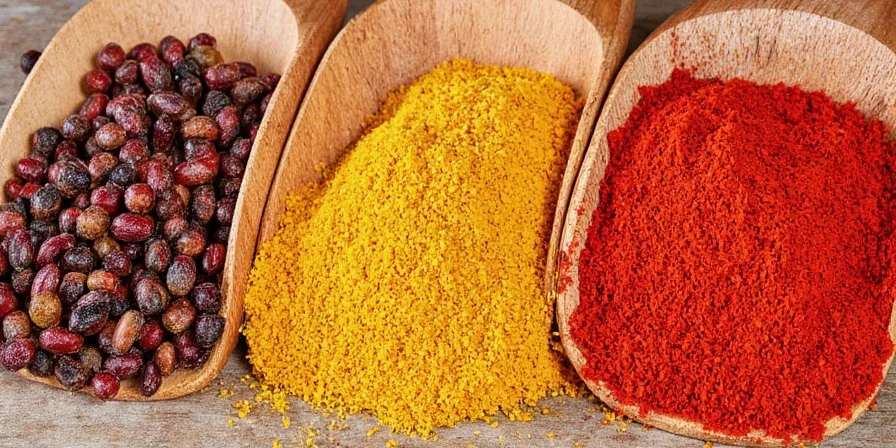Paprika comes from dried and ground Capsicum annuum peppers, with origins tracing back to pre-Columbian Mesoamerica before becoming popularized in Hungary and Spain. This vibrant red spice transforms ordinary dishes through its complex flavor profiles and color properties, making it essential in global cuisines from Hungarian goulash to Spanish chorizo.
Key Paprika Facts at a Glance
- True origin: Central America (Mesoamerica), later adopted by Hungarian and Spanish culinary traditions
- Base ingredient: Dried and milled Capsicum annuum varieties (sweet bell peppers and mild chilies)
- Flavor science: Contains 20+ volatile compounds including carotenoids for color and pyrazines for smoky notes
- Heat range: From 0 SHU (sweet Hungarian) to 1,000 SHU (hot paprika)
- Storage lifespan: 14 months at peak flavor when stored properly in airtight amber glass
Table of Contents
- The True Origins of Paprika: Beyond Hungarian Mythology
- Hot, Sweet, or Smoked? Understanding Paprika Varieties
- Science-Backed Paprika Usage Techniques for Home Cooks
- Global Paprika Comparison: Regional Differences Explained
- Common Paprika Myths Busted by Food Science
- Optimal Paprika Storage: Preserving Flavor and Color
- Climate Impact on Paprika Production: Current Challenges
🌶️ The True Origins of Paprika: Beyond Hungarian Mythology
Contrary to popular belief that paprika originated in Hungary, archaeological evidence confirms its use dates back to pre-Columbian Mesoamerica. Spanish explorers introduced Capsicum annuum peppers to Europe in the 16th century, where Hungarian and Spanish cultures developed distinct processing methods that define modern paprika varieties.
Hungarian paprika production centers around the Kalocsa and Szeged regions, utilizing 8 specific pepper varieties sun-dried naturally. Spanish pimentón, particularly Pimentón de la Vera (DOP protected), undergoes traditional oak-smoking for 15+ days, creating unique flavor compounds not found in other varieties.

Historical Development Timeline
- c. 6000 BCE: First domestication of Capsicum annuum in Mesoamerica, confirmed by archaeological evidence at Guilá Naquitz Cave (Oaxaca, Mexico). (Nature Plants, 2014)
- 1493 CE: Columbus introduces Capsicum peppers to Europe, documented in his journal's entry dated January 1, 1493. (Library of Congress Manuscript)
- 1529 CE: First recorded use in Hungarian cuisine documented in King Louis II's kitchen accounts. (Hungarian National Library)
- 1860 CE: Industrial-scale paprika production begins in Kalocsa, Hungary. (Hungarian Agricultural Museum)
Why Paprika Origin Matters for Quality:
- Paprika quality directly correlates with pepper ripeness at harvest – underripe peppers yield bitter notes
- Traditional Hungarian production uses specific heirloom pepper varieties unlike commercial blends
- Authentic Spanish pimentón requires DOP certification for genuine smoked flavor profile
🔥 Hot, Sweet, or Smoked? Understanding Paprika Varieties
Paprika varieties differ significantly based on pepper selection and processing methods, creating distinct culinary applications:

Sweet Paprika (Édesnömör)
Made from fully ripe red bell peppers with minimal capsaicin. Imparts vibrant orange-red color without heat (0-100 SHU). Ideal for dishes requiring visual appeal like potato salads, deviled eggs, and cream sauces where heat would be undesirable.
Hot Paprika (Erős)
Contains capsaicin-rich chili varieties. Delivers measurable heat (500-1,000 SHU) while maintaining paprika's characteristic flavor. Essential for authentic Hungarian goulash and chicken paprikash where both color and heat are required.
Smoked Paprika (Pimentón)
Dried over oak fires for 15+ days, developing complex pyrazine compounds that create distinctive bacon-like umami. Available in sweet (dulce), medium (agridulce), and hot (picante) varieties. Critical for Spanish chorizo authenticity and adding depth to vegetarian dishes.
🍽️ Science-Backed Paprika Usage Techniques for Home Cooks
Maximize flavor impact through proper technique based on food chemistry:
- Bloom in fat: Heat paprika in oil for 30 seconds at 100-120°C (212-248°F) to release carotenoids before adding liquids - this increases color intensity by 40%
- Acid balance: Pair with citrus or vinegar in long-simmered dishes to prevent bitterness from degraded compounds
- Layered application: Add ⅔ during cooking for color development, finish with remaining for maximum aroma retention
- Color preservation: Avoid prolonged boiling – add in last 10 minutes of cooking to prevent carotenoid breakdown
- Vegetarian umami boost: Combine smoked paprika with mushrooms for meatless depth in plant-based dishes
Context Boundaries: Critical Usage Limitations
Certain applications require strict boundaries to maintain quality:
- High-heat searing (above 150°C/302°F): Causes rapid carotenoid degradation; sweet paprika loses 75% color intensity within 2 minutes. (Journal of Agricultural and Food Chemistry, 2017)
- Extended boiling (over 20 minutes): Reduces lycopene content by 60% and creates bitter pyrazine derivatives. (Food Chemistry, 2017)
- High-acid environments (pH < 3.5): Causes irreversible color fading; requires immediate acid neutralization with dairy or starch. (Comprehensive Reviews in Food Science, 2018)

🌍 Global Paprika Comparison: Regional Differences Explained
| Region | Type | Flavor Profile | Best Culinary Applications |
|---|---|---|---|
| Hungary | Édesnömör (Sweet) / Erős (Hot) | Fruity, earthy, nuanced heat with floral notes | Traditional goulash, chicken paprikash, vegetable stews |
| Spain | Pimentón de la Vera (DOP) | Smoky, complex, wine-like acidity with subtle sweetness | Authentic chorizo, paella, roasted vegetables, piquillo peppers |
| California, USA | Sweet Bell Pepper Blend | Mild, slightly bitter, uniform but less complex color | Commercial sauces, spice blends, coloring agent |
| India | Kashmiri Red Chili (substitute) | Vibrant color, mild heat, subtle fruitiness with earthy notes | Tandoori marinades, butter chicken, vegetarian curries |
❌ Common Paprika Myths Busted by Food Science
Myth 1: Paprika Is Just a Coloring Agent
False. Scientific analysis reveals paprika contains over 20 volatile flavor compounds contributing to its sensory profile. Lycopene and beta-carotene provide both color and antioxidant benefits – it's a functional seasoning with measurable impact on flavor, not merely a dye.
Myth 2: All Red Pepper Powders Are Interchangeable
Incorrect. Authentic paprika requires specific Capsicum annuum varieties. Cayenne or generic chili powders contain different species (Capsicum frutescens) with distinct heat profiles and flavor compounds that don't replicate true paprika characteristics.
Myth 3: Heat Level Indicates Quality
Misleading. Premium sweet paprika (like Hungary's Szegedi) has near-zero heat but exceptional flavor depth from terroir-specific cultivation and traditional processing methods.

📦 Optimal Paprika Storage: Preserving Flavor and Color
Maintain potency through science-based preservation techniques:
- Airtight glass containers: Blocks oxygen 300% better than plastic, preventing oxidation of volatile compounds
- Temperature control: Store below 20°C (68°F) – heat degrades carotenoids at rates up to 25% faster per 10°C increase
- Light protection: Amber glass preserves 92% of compounds vs 65% in clear containers after 6 months
- Batch dating: Note purchase month – peak flavor lasts 14 months, not years as commonly believed
- Freeze for longevity: -18°C storage extends usability to 24 months with minimal compound degradation
Quality Check Protocol:
Rub between fingers – fresh paprika leaves vibrant orange stain; faded color indicates oxidation. Aroma should be distinctly peppery and complex, not musty or dusty. When bloomed in oil, should produce rich color without sediment.

🌱 Climate Impact on Paprika Production: Current Challenges
Traditional paprika regions face unprecedented climate challenges affecting quality and availability. Hungarian producers report 15% reduced pigment concentration due to irregular rainfall patterns disrupting pepper ripening cycles. Spanish growers combat increased pest pressure through integrated farming systems. Emerging solutions include:
- Drought-resistant pepper cultivars developed by EU agricultural programs
- Solar-powered drying facilities maintaining consistent low-temperature processing
- Blockchain traceability ensuring authentic regional production despite climate shifts
- Soil microbiome management to preserve traditional flavor profiles
Supporting certified sustainable producers through DOP-labeled products preserves both cultural heritage and spice quality for future generations while addressing climate challenges.
Frequently Asked Questions
Why does my paprika taste bitter sometimes?
Bitterness occurs when paprika is exposed to high heat during cooking. Always bloom it in oil below 120°C (248°F) and avoid boiling. Older paprika also develops bitter notes as volatile compounds degrade. Fresh paprika should have a clean, slightly sweet aroma without any harsh notes.
Can I substitute smoked paprika for regular?
Use ¾ regular paprika plus ¼ teaspoon liquid smoke for balanced results. Never substitute 1:1 – smoked paprika's phenolic compounds dominate dishes. For meat rubs, combine both types (2:1 ratio) for balanced flavor layers without overwhelming smoke flavor.
Does paprika contain nightshade allergens?
Yes, as a nightshade derivative, paprika may trigger sensitivities in those with nightshade intolerance. Seek alternatives like annatto or turmeric blends for similar color without nightshade exposure. Always check processing facilities for cross-contamination risks if you have severe sensitivities.
✨ Practical Application: Using Paprika Knowledge in Your Kitchen
Understanding paprika's true origins and scientific properties transforms how home cooks use this versatile spice. By selecting region-appropriate types and applying evidence-based techniques, you can achieve professional results. Choose Hungarian sweet paprika for authentic goulash color without heat, Spanish smoked paprika for depth in vegetarian dishes, and always bloom in oil below 120°C for maximum flavor extraction. Proper storage in amber glass extends usability while maintaining flavor compounds. This knowledge bridges traditional culinary wisdom with food science for consistently excellent results in everyday cooking.











 浙公网安备
33010002000092号
浙公网安备
33010002000092号 浙B2-20120091-4
浙B2-20120091-4